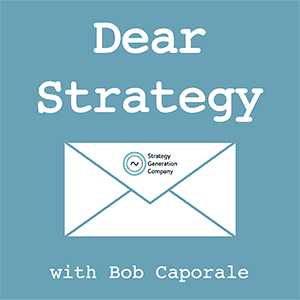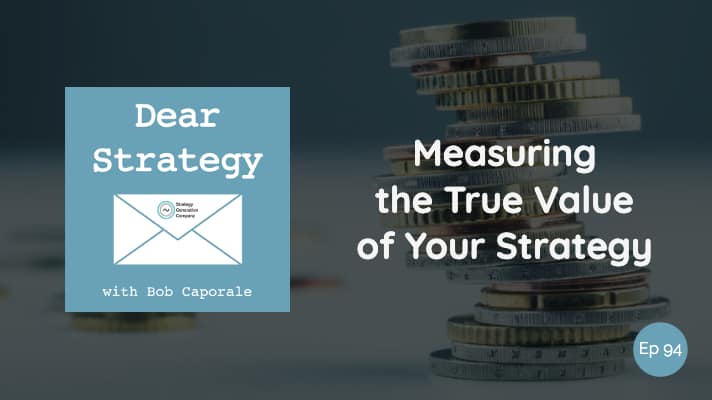Dear Strategy:
“What is the appropriate measure for the value of a project or product? Raw sales? Profit contribution? Something else?”
Ah – sales and profit…the staples of any good strategic dashboard. And something else? Well, how about adding market share? Then you’ll have the 3 most common metrics that I typically see people using to measure the success of their strategies.
But that’s way too easy of an answer. So, let’s go just two points beyond.
Point #1
If you are going to use the magic trilogy of sales, profit, and market share to measure the value of your project or product, just keep in mind that those are all static measurements – meaning that you’ll have no idea if they are good or bad results without having something to compare them to.
For example, if you told me that your product delivered $5M in revenue last year, would that be a good result, a bad result, or something in between? To some, $5M would be a staggering number, while to others, that would be a raging failure. Profit might be a bit easier to figure out, but only if it’s zero or below. Anything above that is anyone’s guess.
What I’m driving at is that those measurements only become meaningful when you compare them to your commitments. If you’re talking about a strategy, then you should be working with a set of strategic goals and objectives. If you achieved them, then you succeeded; if not, then you failed. Simple – but still a critical baseline that you absolutely cannot leave out of the equation.
For projects, it’s the same basic principle, but with a bit more preaching on my end. Why? Because it’s all too common for companies to scrutinize the heck out of every dollar and cent that’s asked for in connection with a project’s business case. Then, once the money is approved, that same business case is rarely looked at again! It just boggles the mind! Don’t get me wrong, I understand that we’re only as good as our last forecast. But, my goodness, for all the effort that we put into beating people up over the accuracy of their business cases, we could at least have the common courtesy of beating them up again when those business cases aren’t met! Or – better yet – celebrating profusely when those business cases are blown out of the water.
“It’s all too common for companies to scrutinize the heck out of every dollar and cent that’s asked for in connection with a project’s business case. Then, once the money is approved, that same business case is rarely looked at again!”
But I’m starting to digress. So, onto…
Point #2
As much as I support using sales, profit, and market share as measurements of strategic success, they actually aren’t the best measurements to use. Or, at least they aren’t the only ones you should be using.
If you’re looking to find the TRUE value of your strategy (or your product, or your project, or anything else in your business for that matter), then you should look no further than to your customers.
Back in Episode 77, we talked about Determining a Product’s True Value Proposition. Be sure to go back and give that a look or a listen if you have a chance.
To review: a value proposition is defined as the value that your product brings to your customers. The trick here is to realize that value is going to be defined differently for every product and for every customer. And that’s something that can admittedly be a bit challenging to figure out.
As an example, let’s say that I’m selling a brand-new internet router that is the fastest on the market. You might be inclined to say that “being fast” is the product’s value proposition. But what does “being fast” really mean to your customers? And what actual value is that going to bring to them?
If I am a business customer, maybe more speed means more transactions. And more transactions could mean more revenue and ultimately more profit. In that case, the value proposition to those customers will be whatever additional profit that new internet router will put into their pockets.
On the other hand, that same speed in the hands of a consumer customer may have a totally different value placed on it. In this case, more speed might translate into a greater ability to stream long movies or download large files that could not have been easily downloaded before. This won’t equate to more dollars for that consumer, but it will equate to greater satisfaction and more emotional well-being. That may be harder to put into quantifiable terms, but it is, in fact, the value that you’re ultimately going to need to capture (perhaps through surveys, satisfaction scores, etc.)
The point is that the TRUE value of your strategy can really only be measured in terms of the value it brings to the customers you are trying to serve. In business, this is the only value that really matters because, without it, sales, profit, and market share will surely cease to exist.
So, the short answer to this question is:
Yes – Revenue;
Yes – Profit;
Yes – Market Share; and
YES – Customer Value
And all of that compared to whatever value you said you were going to bring.
Listen to the podcast episode
Dear Strategy: Episode 094

###
Are you interested in strategy workshops for your product, marketing, or business managers? If so, please be sure to visit Strategy Generation Company by clicking the link below:
 Bob Caporale is the founder of Strategy Generation Company, the author of Creative Strategy Generation and the host of the Dear Strategy podcast. You can learn more about his work by visiting bobcaporale.com.
Bob Caporale is the founder of Strategy Generation Company, the author of Creative Strategy Generation and the host of the Dear Strategy podcast. You can learn more about his work by visiting bobcaporale.com.







